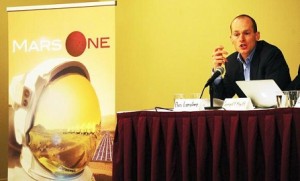More than 200,000 people from 140 countries have applied to go to Mars and never return, the group behind an ambitious venture to colonize the inhospitable red planet said Monday.

Bas Lansdorp, a Dutch engineer and entrepreneur, plans to establish a permanent base on Mars in a mission he hopes will take off in 2022 if he can find the necessary $6 billion.
One in four of the 202,586 applicants for the one-way trip are Americans, said Mars One, the non-profit group which initiated its hunt for “would-be Mars settlers” in April.
There are also hopefuls from India (10 percent), China (six percent) and Brazil (five percent), among other countries, it said.
By 2015, Mars One expects put up to 10 four-member teams through intensive training, with the first of those teams reaching to Mars in 2023 on a high-risk journey that would take seven months to complete.
If they survive the trip, the human Martians will have to deal with minus 55 degrees C (minus 67 F) temperatures in a desert-like atmosphere that consists mainly of carbon dioxide.
They’ll also have to consent to being observed back on Earth full-time as stars of a reality TV show that would help cover expenses.
The project has the support of Gerard ‘t Hooft, the Dutch joint winner of the Nobel prize for physics in 1999.
“The long term aim is to have a lasting colony,” said ‘t Hooft in New York in April. “This expansion will not be easy. How soon that will be accomplished is anyone’s guess.”
Space agencies including NASA have expressed skepticism about the viability of Lansdorp’s plan, saying the technology to establish a human colony on Mars does not exist.
Mars One says on its website that the mission is a decade-long endeavor, with funding intended to come from the global audience of an interactive, televised broadcast of every aspect of the mission.
So far, there have only been unmanned missions to Mars undertaken by NASA, which has signaled its intent to send astronauts there within 20 years.
AFP



